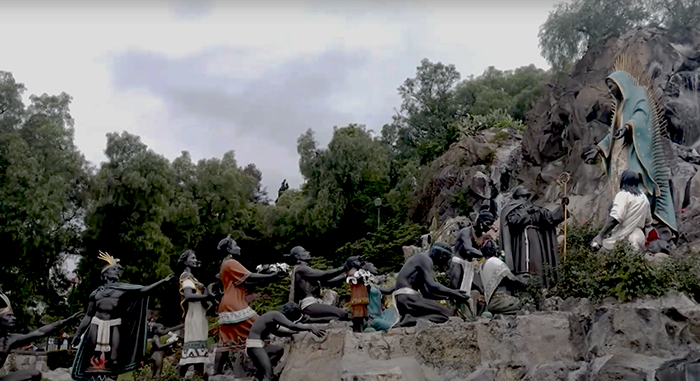
MIDTOWN MANHATTAN — Some 80 years before the Pilgrims voyaged west seeking religious freedom in the “New World,” the Catholic faith was already embraced by some longtime inhabitants of North and South America — the native people.
Catholicism came to these indigenous groups concurrent with European colonialism, a history wrought by violent conquest through warfare and disease.
Still, devout Native American Catholics say their ancestors’ conversions were an expression of the deep spiritual connections they already had with the Creator.
The Knights of Columbus believe this legacy of faith can inspire all Catholics, so to tell this story, they have embarked on a Native American Solidarity Initiative.
They also want to start a conversation that acknowledges the tragedies of colonialism and to seek reconciliation through communion with all cultures in the body of Christ.
“Our Supreme Knight (Patrick Kelly) says you can’t tell this story of Catholicism In the Americas without telling the story of the Catholicism of Native Americans,” said Patrick Mason, the organization’s supreme secretary.
“We felt very strongly,” he added, “that this story needed to be told to the broader Church.”
Mason knows the story first-hand.
A lawyer by trade, he is also a member of the Osage tribe, now centered in Oklahoma, but he grew up in Gallup, N.M., in the heart of the Navajo Reservation.
Mason has been involved with Knights much of his adulthood, and relocated with his family to Connecticut last spring after he was elected to be the KOC’s supreme secretary.
His perspectives as a member of the Knights and a Native American are prominently featured in the documentary, “Enduring Faith: The Story of Native American Catholics.” The film, produced by the Knights of Columbus, had its debut last spring on ABC and is available now at kofc.org.
The documentary was produced by filmmaker David Naglieri, who explained that “Enduring Faith” was an outgrowth of the Native American Solidarity Initiative, which began in 2019 under the leadership of Carl Anderson, who has since retired as Supreme Knight.
“The history and deeply ingrained traditions of Native American Catholics demonstrate how Christ reveals Himself through the uniqueness of every culture,” Kelly said. “Our hope is that this film will inspire a greater appreciation of the faithful witness of Native American Catholics.”
The documentary begins by describing how, in 1531, the Blessed Mother Mary, under the title of Our Lady of Guadalupe, appeared to St. Juan Diego, a Native American, on Tepeyac Hill in what today is Mexico City.
But, in the documentary, Mason explained Mary appeared as a woman with the features of Juan Diego’s mestiza race.
“Our Lady of Guadalupe came, not to Europeans, (and) not as a European,” Mason said. “She came as a Native American to a Native American. And that Native American then brought Our Lady of Guadalupe to the Spanish. It was a Native American, bringing our Lady and the faith that she holds in her hands, the faith in Christ, to the Europeans.
“That’s the beauty of Native American Catholicism, and that beauty has not stopped to this day.”
Within a decade of the apparition to Juan Diego, a Franciscan missionary, Marco da Nizza was celebrating Mass among the Zuni people, just 25 miles north of present-day Gallup, Mason said.
The documentary also recounts how French Jesuits forged deep into the northeastern U.S. and brought the faith to Mohawks near Albany, New York. Among them was a teenage girl named Kateri Tekakwitha, who converted to Catholicism at age 19, five years before her death.
But Kateri’s piety and purity — she resisted pressure to marry to stay a virgin — paved the way for her being canonized a saint in 2012.
The documentary shows that many Native American Catholics, like Kateri, were ridiculed by their own people who distrusted anything associated with the Europeans. Many were martyred.
“This is not a faith that was forced onto them,” Mason said. “This is a faith they chose, in light of the fact that it might lead to their deaths.”
The film also describes how Native Americans had a unique missionary role in the 1800s. For example, a few Catholic Mohawks moved west as trappers in the fur trade industry. In the valleys of the Northern Rockies, they told members of the Flathead tribe about the wonders of Christianity.
The Flatheads were so impressed, they journeyed to St. Louis to request their own “Black Robe” missionary. The Jesuits sent Father Pierre-Jean De Smet, who established a mission — the precursor of parishes flourishing today in Western Montana.
Mason said that Juan Diego, Kateri Tekakwitha, and other Native American Catholics cherished their faith willingly because it bridged their spiritual yearnings to the God of Creation.
“So,” he continued, “if you look at a lot of Native cultures and traditions, it’s very heavily connected to the natural world.
“A very common kind of saying among Native peoples is ‘water is life.’ It’s the idea that water is the source and abundance of food and growth and life. I mean that’s in and of itself one of the central tenets to baptism into the Catholic faith. Right?”
Likewise, Mason said, Native Americans value the unborn as God’s creation and eagerly participate in the March for Life in Washington, D.C.
The documentary first aired concurrently with reports of unexplained mass graves at Church-affiliated boarding schools and hospitals set up for “First People” throughout Canada.
Investigations continue as Pope Francis prepares to meet with tribal representatives. Meanwhile, reconciliation is as important as ever, Mason said.
“We need to recognize that and apologize for the wrongs that were done either directly or indirectly,” Mason said. “As part of that, you ask forgiveness, and you express love to your brother and sister in Christ, by living in communion with them.
“So, let’s celebrate the sacrament of the Mass together. And let’s have those listening sessions. All those types of things are what brings about reconciliation.”
